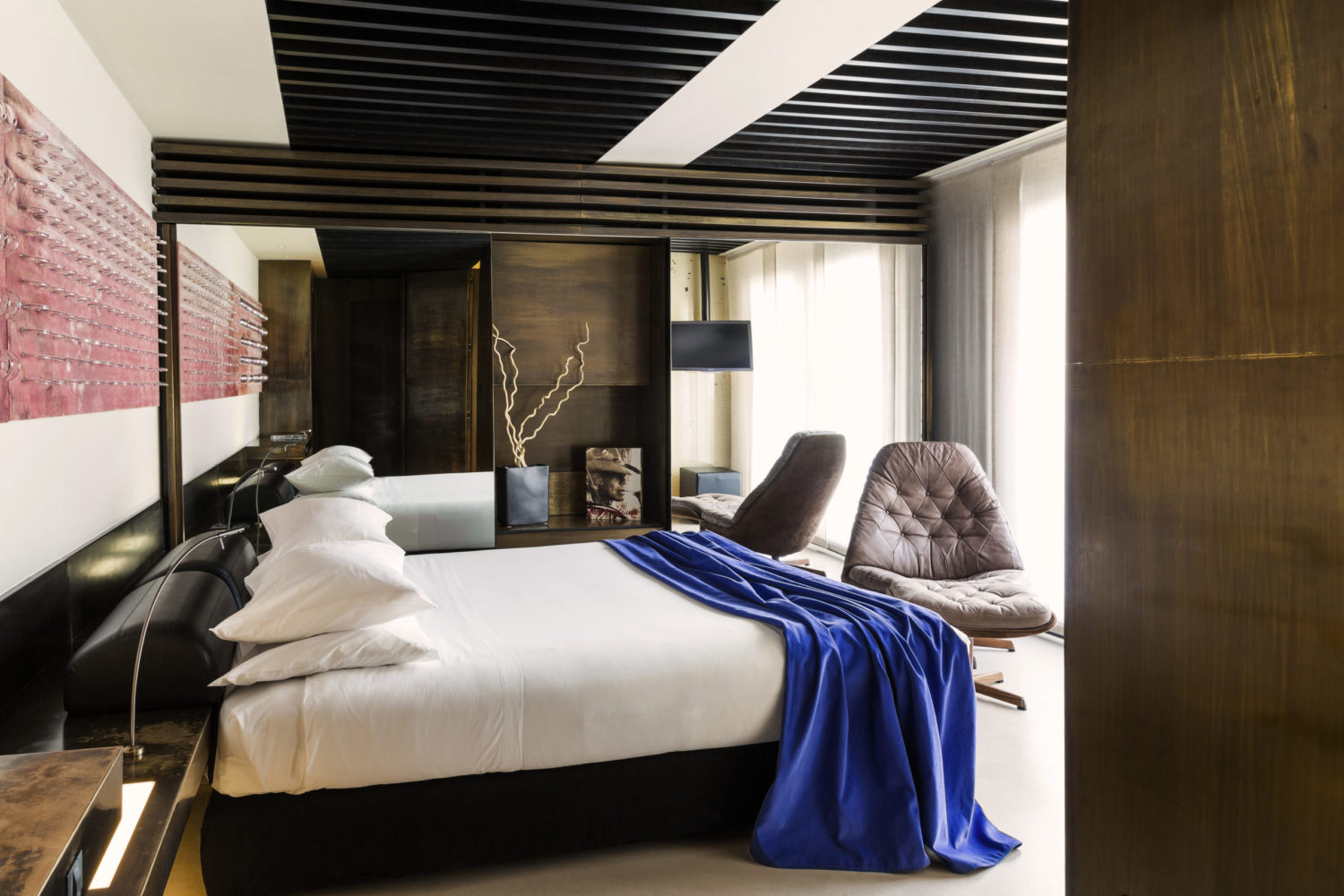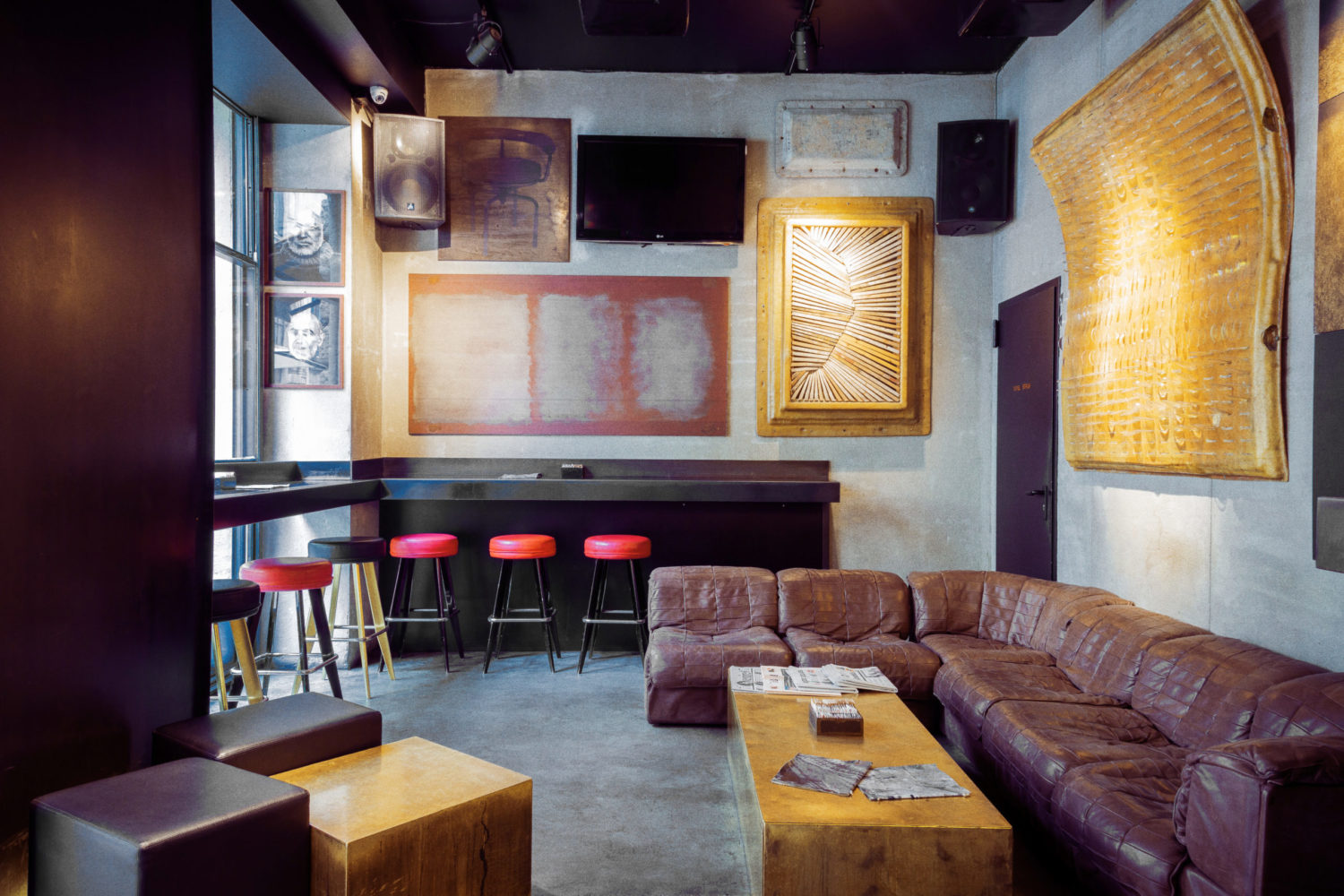On March 24, the 22nd Biennale of Sydney, NIRIN, moved to a digital platform in the wake of COVID-19—a choice that only re enforces the original intention of the exhibition, to “push audiences to see beyond what they know, to challenge history, to be a part of the story and to immerse themselves in inspiration and imagined futures.”
“NIRIN,” the title of the 22nd Biennale of Sydney, translates to “edge” in Wiradjuri, the mother language of the event’s first Indigenous director, Brook Andrew, artist, curator, and Oxford PhD candidate. The name asks the audience to consider perspectives that are often sidelined and introduces a new paradigm for art biennials based on First Nation’s methodologies.

Courtesy of STRAF Hotel & Bar.
Andrew is a multimedia artist, whose work challenges colonial contexts and Euro-centric approaches. He is known for his use of archival material and bold patterns inspired by traditional Wiradjuri carvings. The entire event seems to embody the themes of Andrew’s art and is made more powerful by the multitude of voices—from international artists to researchers and local communities.
Click into the Biennale of Sydney website and a pop up fills your screen, not to notify the visitor about cookies or data protection, but a prompt to recognize and reflect on the event’s context. The message reads: We acknowledge the Gadigal people of the Eora Nation; Boorooberongal people of the Dharug Nation; the Bidiagal and Gamaygal people, on whose ancestral lands and waters NIRIN gathers. NIRIN is a safe place for people to honor mutual respect and the diversity of expression and thoughts that empower us all.

Courtesy of STRAF Hotel & Bar.
With this introduction, patrons can then enter the virtual experience of NIRIN. In the wake of COVID-19, the event has switched to a digital program in partnership with Google Arts and Culture. Patrons may participate in live tours, virtual walk-throughs, podcasts, interactive Q&As, curated tours, and artist takeovers.
“As we move the Biennale to digital spaces,” said Andrew, “I hope people will open themselves up to things that they haven’t thought about and empathize with the shared experiences of others.”
In these uncertain times, this message of solidarity feels particularly poignant. One can’t help but note that the world itself seems on the edge as we talk with Andrew about the possibilities of art to transform and what we can appreciate from the biennial—now accessible to all of us.
WHITEWALL: Was there a moment or artwork that has struck you on a personal level during the biennial’s vernissage?
BROOK ANDREW: All of the artworks in NIRIN resonate with me on a deep personal level. I’m interested in themes, such as transformation, healing and ways of looking at ideas of sovereignty or the decolonial. These pieces are all salient reminders of solidarity in times of need. Art is so important at times like the now, and NIRIN provides a space for those without a voice to incite real change in our visitors, while also creating an opportunity to reflect and connect with not only our own histories, but also global issues that are urgent and that involve our own responsibilities to each other and the planet.
WW: You’ve talked about leading the 22nd Biennale of Sydney, with a First Nations methodology; can you talk to us about what that looks like in practice?
BA: When we say that this Biennale is First-Nations-led it’s really about honing in on my own Wiradjuri heritage’s perception of what art is: challenging the dominant narrative of art and seeing life and creativity outside of the contained and restricted. In NIRIN we have artists who are First Nations, but we also have many artists who are not, we also have artists who are not necessarily known as artists who are using this First Nations methodology to break boundaries and reimagine stories. For example, artists such as Adrift Lab, who are a group of researchers, present their work on the impact of plastic pollution on the oceans and its wildlife, as well as on us. We also have artists like Laure Prouvost from France, and her work draws on unresolved anxieties that stalk our time and ourselves. These works are very much aligned with the themes of NIRIN and support Wiradjuri methodologies.
WW: You say that “artists have the opportunity to inspire and lead through difficult times”—can you elaborate on this with our current context?
BA: NIRIN, which means “edge” in Wiradjuri, my mother’s language, is about offering different perspectives. The 22nd Biennale of Sydney is the first time we have seen such a high number of people of color, non-binary and queer artists come together to share stories about healing and transformation. These artists are seizing the opportunity to lead communities through difficult times. At a time like our current situation, when we are pitted against adversity, it is so powerful to take time to reflect and listen to alternative ways of working together.
WW: You adorned the entry court of the Biennale of Sydney, with text from the late artist and land rights activist, Pitjantjatjara artist Kunmanara Williams. Can you talk to us about the interplay of architecture and artwork in this case?
BA: Before his passing in March 2019, Mr Williams was planning a political protest piece for the Biennale of Sydney. His widow Tuppy Ngintja Goodwin, his lifelong friend and collaborator Sammy Dodd, and his community carried the project forward. His inspirational words painted on large canvases fill the space of the entrance court at the Art Gallery of New South Wales. In the entrance court, his banners open up a dialogue across the architectural space and redefine the status quo of a long established institution like the Art Gallery of New South Wales. Mr William’s powerful words and images in this space project his belief that words can effect change, and such an installation, where visitors could download an app to translate the words into English,
invites audiences to see and hear his stories in a dynamic sensory experience. Although with the current news that the Biennale has closed its public exhibitions due to COVID-19, the interplay between works will be available to audiences to engage with digitally soon.
WW: Does the theme of NIRIN interplay or contradict with that of May You Live in Interesting Times from the 2019 Venice Biennale? Example: Ralph Rugoff, curator of the 58th Venice Biennale said in his opening statement “let us acknowledge at the outset that art does not exercise its forces in the domain of politics.”
BA: I think Ralph is interested in global politics and this in some way is a tongue in cheek response. NIRIN is a concept through First Nation methodologies to look outside of the usual often Eurocentric way of looking at a particular style of art and ideas encapsulated in this art. NIRIN steps outside of this often narrow view of expression and offers not only alternative creative projects but showcases a more global view of art not restricted by the economies both financial and creative of this Eurocentric view. Not one or a few institutes can hold the meaning of art as if there is only one golden chalice. After all, the historical model of the Biennale is built on top of a colonial project that failed to even acknowledge creativity from all parts of the world; instead most of it was trapped in ridiculous values of primitivism.
WW: The 22nd Biennale of Sydney, 250th anniversary of Captain Cook’s voyage to Australia, which seems significant, especially given that you are the first Indigenous artist to lead to the event. With this in mind, how is NIRIN grappling with a, as you put it—”contemporary life laden with unresolved past anxieties and hidden layers of the supernatural,” and what role does sovereignty play looking to the future?
BA: One cannot run away from this truth of historical fact. The fact that colonialism internationally destroyed and subjugated millions of people. The evidence is in the museums of the ruling class and international, mainly European/Western museums. No different, is the fact that most objects and human remains belonging to the ancestors of First Nation Australians are also scattered amongst this messy history.
Now there is the big elephant in the room—the anniversary of Captain Cook. I think it’s self-explanatory. For starters, Australia should be a republic. Secondly, restitution of First Nation’s objects and the repatriation of human remains. In 2020 it is pretty unfathomable to even contemplate that this would happen in so-called ‘first world nations.’
The history in Australia like other places is very unresolved. It’s how we approach and face up to this anniversary, through bravery and solidarity, is how we will possibly make a change to shift the old narrative of pain and division and invisibility to one that holds some kind of honor and a new direction of equality. Sovereignty is also the acceptance that for a misguided reason, people in Australia, which means it’s politics and guidance, has been off path, off mission and off somewhere in the denial of the historical facts of this nation. Sovereignty means acknowledging that there are other histories and peoples who owned these places and still have claim to them – it also means that all Australians need to come to the realization that there was a war here between the British and First Nations people and if we don’t fix it soon, it’s going to continue to be a broken place.
WW: What is on the horizon for you?
BA: The horizon always seems endless—it’s like gathering as I walk then sharing and collaborating and some rest, it’s an often unchartered journey driven by intuitive trust. Some don’t like this path or this horizon.





